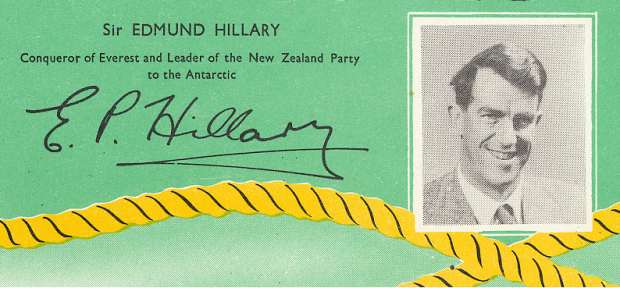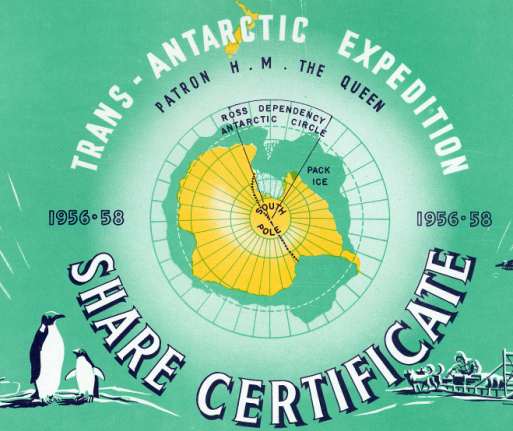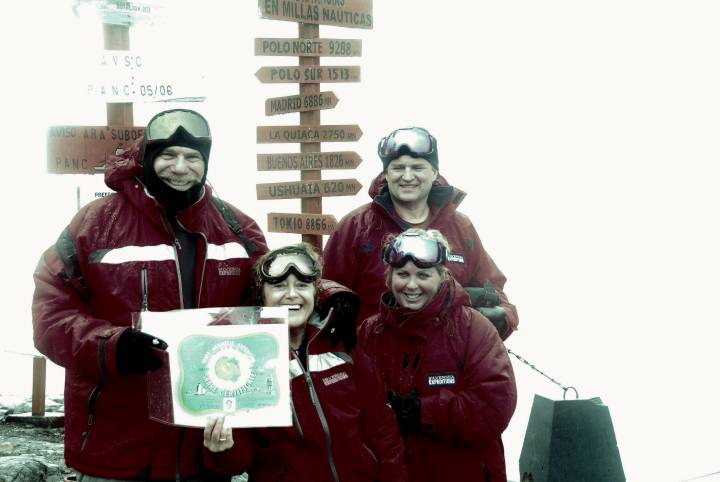Beautiful and colorful unissued certificate from the Trans-Antarctica Expedition printed in 1958. This historic document has an ornate border around it with a vignette of penguins, explorers, and a picture of Sir Edmund Hillary. This item is over 55 years old. This certificate has the printed signature of Sir Edmund Hillary as Conqueror of Mt. Everest and leader of the New Zealand Party to the Antarctic, and Charles M. Bowden, Chairman of the Ross Sea Committee. 


Bob Kerstein and Friends holding a Trans - Antarctica Expedition Certificate at Base Brown, Antarctica in February 2013 On May 29, 1953, Sir Edmund Hillary and Nepalese Sherpa Tenzing Norgay became the first people to successfully climb Mount Everest, the highest point on earth. Until that climb, Hillary had led the quiet life of a beekeeper in New Zealand, but the unprecedented feat led him to fame, and soon after the ascent he was knighted by the Queen of England. Sir Edmund Hillary also made history in the Antarctic. Together with Sir Vivian Fuchs, he led the Commonwealth Trans-Antarctic Expedition (1955-58) which made the first successful overland crossing of the continent. He later led another Antarctic expedition which included the first ascent of Mount Herschel. He has received many honors and awards, and is honorary president of New York's Explorers Club. Sir Edmund was for many years the New Zealand High Commissioner in India. May 18, 2002 - KATHMANDU - Nepal said on Sunday it would award honorary citizenship to Sir Edmund Hillary, one of the first two men to climb Mount Everest, on the 50th anniversary of the ascent of the world's highest mountain. "A certificate of honorary citizenship will be handed over to Hillary next week," Home Secretary Tika Dutta Niraula told Reuters, adding this was the first such award to a foreigner. Hillary, a former beekeeper from New Zealand, and Nepali sherpa, Tenzing Norgay, climbed the 29,035-foot Everest summit on May 29, 1953, becoming the first to achieve the feat.
Charles Moore Bowden (1886 10 July 1972) was a New Zealand politician of the National Party. Bowden was born in Dunedin in 1886. He received his education at Auckland Grammar School. After school, he was briefly with an auctioneering firm before joining Kempthorne Prosser. When his family moved to Wellington, he joined W.M. Bannatyne and Co, where he moved into accounting. He became self employed and established the accountancy firm Bowden, Bass and Cox in 1923. In the same year, he was president of the New Zealand Society of Accountants, and afterwards president of the Wellington branch of the Chamber of Commerce (19241925). For almost a decade, he was chairman and managing director of Wairarapa Farmers in Masterton (19271936), and he was a director of Bannatyne and Co. He represented the Wellington West electorate in Parliament from 1943 to 1946, and then the Karori electorate from 1946 to 1954, when he retired. He was a cabinet minister in the First National Government. He was Minister of Customs (19491954), Minister of Industries and Commerce (19491950), and Minister of Stamp Duties (19491952). In May 1955 he was appointed chairman of the Ross Sea Committee to organise New Zealand participation in the Commonwealth Trans-Antarctic Expedition. Bowden Glacier lying on the southeast flank of Salient Ridge that flows northeast to Blue Glacier, Victoria Land, was named by the New Zealand Geographic Board in 1994 for Bowden during Sir Edmund Hillary's South Pole Expedition, part of the Commonwealth Trans-Antarctic Expedition in 1957. He was appointed director of the Bank of New Zealand and chairman of the New Zealand Historic Places Trust. Bowden died on 10 July 1972.



Bob Kerstein and Friends holding a Trans - Antarctica Expedition Certificate at Base Brown, Antarctica in February 2013
Charles Moore Bowden (1886 10 July 1972) was a New Zealand politician of the National Party. Bowden was born in Dunedin in 1886. He received his education at Auckland Grammar School. After school, he was briefly with an auctioneering firm before joining Kempthorne Prosser. When his family moved to Wellington, he joined W.M. Bannatyne and Co, where he moved into accounting. He became self employed and established the accountancy firm Bowden, Bass and Cox in 1923. In the same year, he was president of the New Zealand Society of Accountants, and afterwards president of the Wellington branch of the Chamber of Commerce (19241925). For almost a decade, he was chairman and managing director of Wairarapa Farmers in Masterton (19271936), and he was a director of Bannatyne and Co. He represented the Wellington West electorate in Parliament from 1943 to 1946, and then the Karori electorate from 1946 to 1954, when he retired. He was a cabinet minister in the First National Government. He was Minister of Customs (19491954), Minister of Industries and Commerce (19491950), and Minister of Stamp Duties (19491952). In May 1955 he was appointed chairman of the Ross Sea Committee to organise New Zealand participation in the Commonwealth Trans-Antarctic Expedition. Bowden Glacier lying on the southeast flank of Salient Ridge that flows northeast to Blue Glacier, Victoria Land, was named by the New Zealand Geographic Board in 1994 for Bowden during Sir Edmund Hillary's South Pole Expedition, part of the Commonwealth Trans-Antarctic Expedition in 1957. He was appointed director of the Bank of New Zealand and chairman of the New Zealand Historic Places Trust. Bowden died on 10 July 1972.








